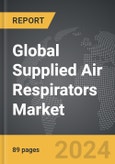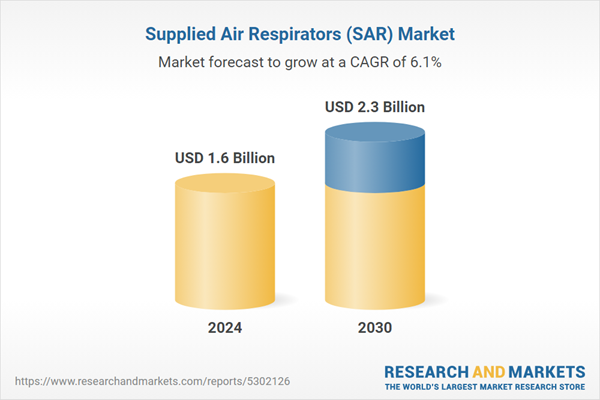Global Supplied Air Respirators (SAR) Market - Key Trends and Drivers Summarized
What Are Supplied Air Respirators (SAR) and How Do They Function?
Supplied Air Respirators (SAR) are sophisticated respiratory protection systems designed to provide breathable air from a remote source, offering superior protection against toxic atmospheres that may not have adequate oxygen levels or that contain dangerous contaminants. These devices deliver clean air to the user through a hose connected to an external source, such as a compressed air cylinder or an air compressor. This design differentiates SARs from other respirators like N95s or PAPRs, which rely on ambient air filtering. SARs are typically equipped with facepieces, hoods, or helmets that create a tight seal around the user's face to prevent the ingress of unfiltered air. The supplied air can be delivered either at a constant flow or as a demand-controlled system, allowing users to adjust airflow according to their needs. These respirators are essential in extreme industrial environments such as chemical processing plants, confined spaces, paint booths, and hazardous material cleanup sites, where airborne contaminants like chemical vapors, fine particulates, and toxic fumes are prevalent. SARs are also frequently used in environments classified as Immediately Dangerous to Life or Health (IDLH) due to their ability to provide continuous, clean air, ensuring the safety of workers when other respiratory devices may not be effective. With various configurations such as pressure-demand systems, escape respirators, and combination SAR and self-contained breathing apparatus (SCBA) models, SARs are a versatile and indispensable tool in the arsenal of occupational safety equipment.How Does SAR Technology Adapt to Extreme Environmental Demands?
Supplied Air Respirator technology has evolved to meet the rigorous demands of hazardous and oxygen-deficient environments, incorporating numerous advanced features that enhance safety and usability. One of the most significant technological adaptations in SARs is the integration of pressure-demand systems, which ensure that air is supplied only when the user inhales, thereby conserving air supply and preventing the buildup of positive pressure that could lead to air wastage. Moreover, advanced SARs now include electronic monitoring systems that track air pressure, flow rates, and user movement in real-time, sending alerts in case of any irregularities that could indicate a malfunction or hazardous exposure. These systems often come with backup air cylinders or emergency escape capabilities, providing an additional layer of safety. Innovations in hose and breathing tube materials have also contributed to the enhanced functionality of SARs, with modern hoses designed to be more flexible, lightweight, and resistant to kinks and chemical degradation. This reduces the strain on the user and allows for greater freedom of movement, which is crucial in confined or complex working environments. Another notable development is the inclusion of noise-canceling technology in full-face SAR helmets, which improves communication and reduces user fatigue in loud industrial settings. Furthermore, specialized SAR configurations, such as those with fire-resistant properties or cooling mechanisms, are now available for extreme conditions like firefighting or high-heat environments. These technological advancements ensure that SARs not only provide superior respiratory protection but also improve user comfort, operational efficiency, and overall safety in the most challenging of work conditions.How Are Industrial Requirements and User Preferences Shaping the SAR Market?
The market for Supplied Air Respirators is being significantly shaped by stringent safety requirements, industry-specific needs, and a growing focus on user comfort and versatility. As industries face increasing regulatory scrutiny to provide adequate respiratory protection, particularly in high-risk sectors like petrochemicals, pharmaceuticals, and metalworking, SARs are gaining prominence as the preferred option for environments where conventional respirators are insufficient. Regulatory bodies such as OSHA and the European Union’s Directive on Chemical Agents have imposed strict guidelines that mandate the use of SARs in IDLH and oxygen-deficient environments, making compliance a top priority for businesses. This regulatory pressure is compounded by the fact that SARs are considered more reliable than negative-pressure respirators in environments with high levels of contaminants, as they provide a continuous supply of breathable air even in the presence of heavy smoke, toxic fumes, or vapors. In terms of user preferences, there is a growing demand for lightweight, ergonomically designed SAR systems that reduce fatigue and allow for greater mobility, addressing one of the main challenges associated with using traditional SARs. Users are also looking for greater modularity and ease of use, prompting manufacturers to design SARs with quick-connect hoses, easy-to-don facepieces, and adaptable configurations that can be tailored for specific tasks. Additionally, the adoption of SARs in non-industrial settings such as emergency response, mining rescue operations, and specialized healthcare applications is expanding, reflecting a broader recognition of the versatility and robustness of SAR systems.What Are the Key Growth Drivers in the Supplied Air Respirator Market?
The growth in the Supplied Air Respirator market is driven by several critical factors, including stringent regulatory mandates, expanding industrial sectors, technological innovations, and an increasing focus on worker safety in hazardous environments. Regulatory compliance remains a primary growth driver, as organizations must adhere to strict standards set by OSHA, the European Union, and other safety agencies that dictate the use of SARs in high-risk occupations and IDLH conditions. These regulations are particularly influential in industries such as oil and gas, chemical manufacturing, metal fabrication, and utilities, where the presence of hazardous gases, insufficient oxygen, and confined space work are common. Furthermore, rapid industrialization in developing economies has led to a surge in infrastructure projects and heavy industry activities, increasing the demand for advanced respiratory protection solutions like SARs. Technological advancements have also played a pivotal role in boosting the adoption of SARs, with innovations such as wireless monitoring systems, lightweight hose materials, and smart air supply management systems enhancing the functionality and appeal of these devices. Another significant growth driver is the increasing emphasis on worker safety and corporate responsibility, as companies seek to reduce the risk of occupational illnesses and fatalities by investing in higher-grade protective equipment. This trend is particularly evident in sectors where employees are exposed to complex hazards that require sophisticated respiratory protection, pushing the demand for SARs equipped with multiple safety features. Finally, the growing acceptance of SARs in emergency services, rescue operations, and even some non-industrial applications highlights their expanding use cases, as organizations across various domains prioritize the health and safety of their personnel in diverse and unpredictable environments. These growth drivers collectively underscore the expanding role of Supplied Air Respirators in ensuring safety and compliance in both traditional and emerging industrial settings.Report Scope
The report analyzes the Supplied Air Respirators (SAR) market, presented in terms of units. The analysis covers the key segments and geographic regions outlined below.Segments: Segment (Supplied Air Respirators (SAR)).
Geographic Regions/Countries: World; United States; Canada; Japan; China; Europe (France; Germany; Italy; United Kingdom; Spain; Russia; and Rest of Europe); Asia-Pacific (Australia; India; South Korea; and Rest of Asia-Pacific); Latin America (Argentina; Brazil; Mexico; and Rest of Latin America); Middle East (Iran; Israel; Saudi Arabia; United Arab Emirates; and Rest of Middle East); and Africa.
Regional Analysis
Gain insights into the U.S. market, valued at $411.6 Million in 2024, and China, forecasted to grow at an impressive 9.6% CAGR to reach $549.2 Million by 2030. Discover growth trends in other key regions, including Japan, Canada, Germany, and the Asia-Pacific.Why You Should Buy This Report:
- Detailed Market Analysis: Access a thorough analysis of the Global Supplied Air Respirators (SAR) Market, covering all major geographic regions and market segments.
- Competitive Insights: Get an overview of the competitive landscape, including the market presence of major players across different geographies.
- Future Trends and Drivers: Understand the key trends and drivers shaping the future of the Global Supplied Air Respirators (SAR) Market.
- Actionable Insights: Benefit from actionable insights that can help you identify new revenue opportunities and make strategic business decisions.
Key Questions Answered:
- How is the Global Supplied Air Respirators (SAR) Market expected to evolve by 2030?
- What are the main drivers and restraints affecting the market?
- Which market segments will grow the most over the forecast period?
- How will market shares for different regions and segments change by 2030?
- Who are the leading players in the market, and what are their prospects?
Report Features:
- Comprehensive Market Data: Independent analysis of annual sales and market forecasts in US$ Million from 2024 to 2030.
- In-Depth Regional Analysis: Detailed insights into key markets, including the U.S., China, Japan, Canada, Europe, Asia-Pacific, Latin America, Middle East, and Africa.
- Company Profiles: Coverage of players such as Covidien, DeVilbiss Healthcare(Drive Medical), Drager USA, Fisher and Paykel Healthcare, Invacare and more.
- Complimentary Updates: Receive free report updates for one year to keep you informed of the latest market developments.
Some of the 34 companies featured in this Supplied Air Respirators (SAR) market report include:
- Covidien
- DeVilbiss Healthcare(Drive Medical)
- Drager USA
- Fisher and Paykel Healthcare
- Invacare
- Maquet
- Philips Respironics
- ResMed
- Teleflex
Tariff Impact Analysis: Key Insights for 2025
Global tariff negotiations across 180+ countries are reshaping supply chains, costs, and competitiveness. This report reflects the latest developments as of April 2025 and incorporates forward-looking insights into the market outlook.The analysts continuously track trade developments worldwide, drawing insights from leading global economists and over 200 industry and policy institutions, including think tanks, trade organizations, and national economic advisory bodies. This intelligence is integrated into forecasting models to provide timely, data-driven analysis of emerging risks and opportunities.
What’s Included in This Edition:
- Tariff-adjusted market forecasts by region and segment
- Analysis of cost and supply chain implications by sourcing and trade exposure
- Strategic insights into geographic shifts
Buyers receive a free July 2025 update with:
- Finalized tariff impacts and new trade agreement effects
- Updated projections reflecting global sourcing and cost shifts
- Expanded country-specific coverage across the industry
Table of Contents
Companies Mentioned (Partial List)
A selection of companies mentioned in this report includes, but is not limited to:
- Covidien
- DeVilbiss Healthcare(Drive Medical)
- Drager USA
- Fisher and Paykel Healthcare
- Invacare
- Maquet
- Philips Respironics
- ResMed
- Teleflex
Table Information
| Report Attribute | Details |
|---|---|
| No. of Pages | 89 |
| Published | April 2025 |
| Forecast Period | 2024 - 2030 |
| Estimated Market Value ( USD | $ 1.6 Billion |
| Forecasted Market Value ( USD | $ 2.3 Billion |
| Compound Annual Growth Rate | 6.1% |
| Regions Covered | Global |









